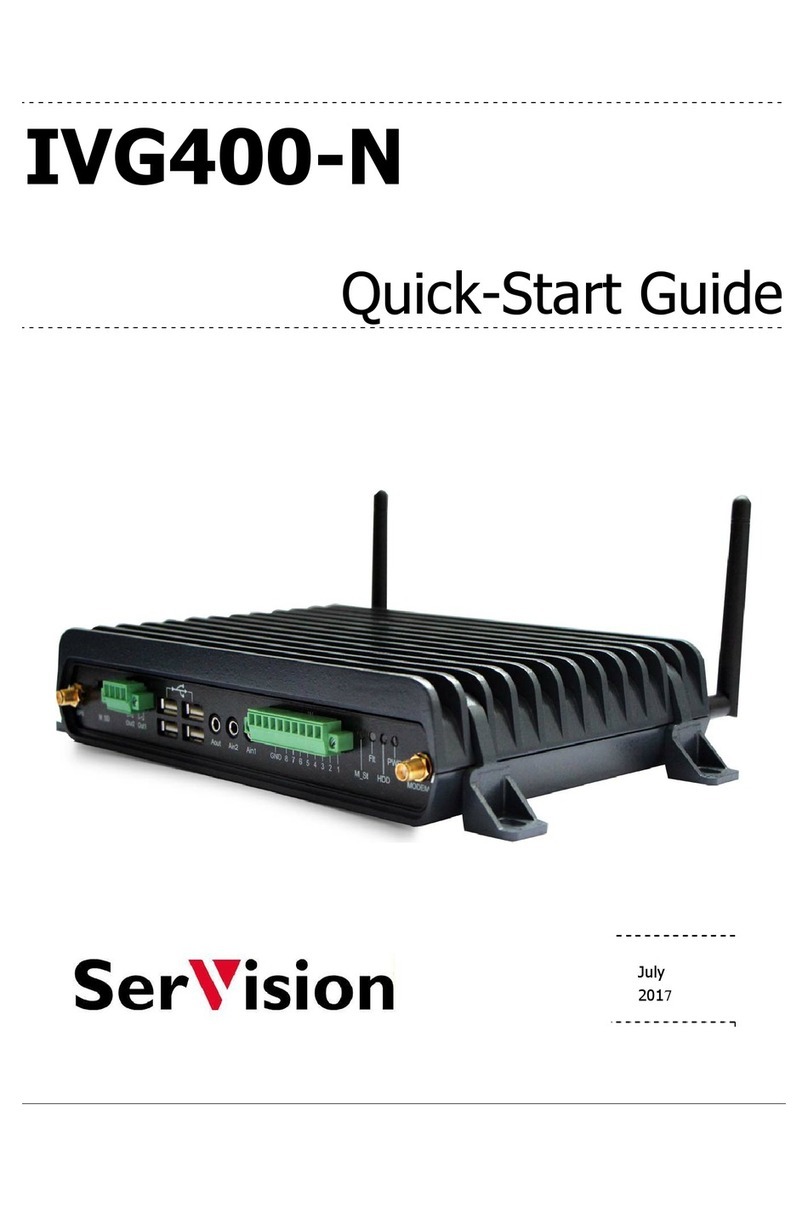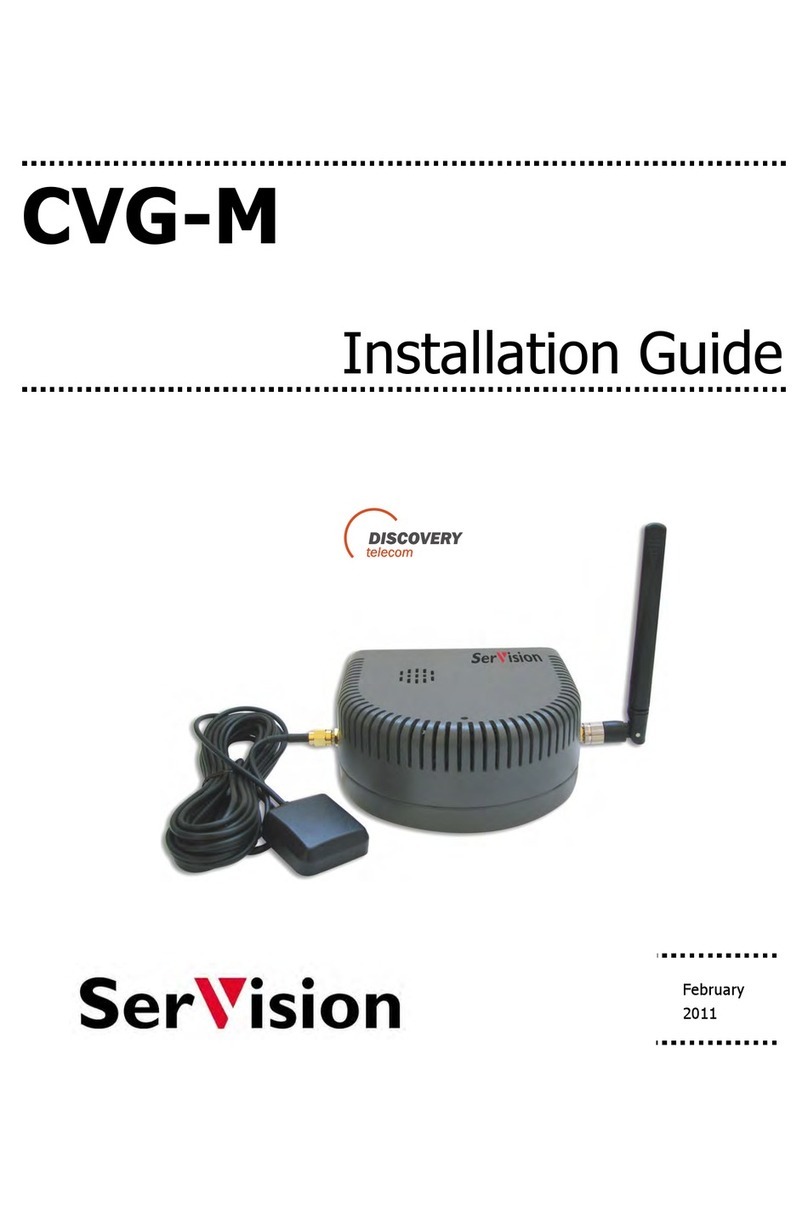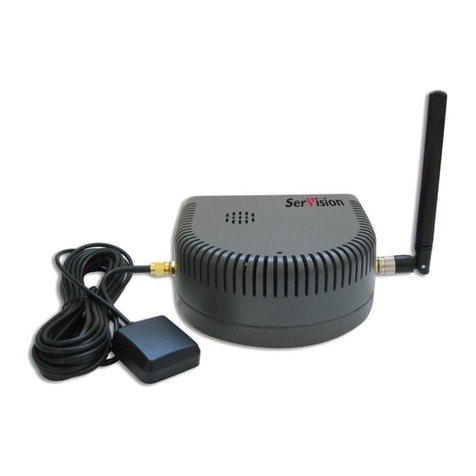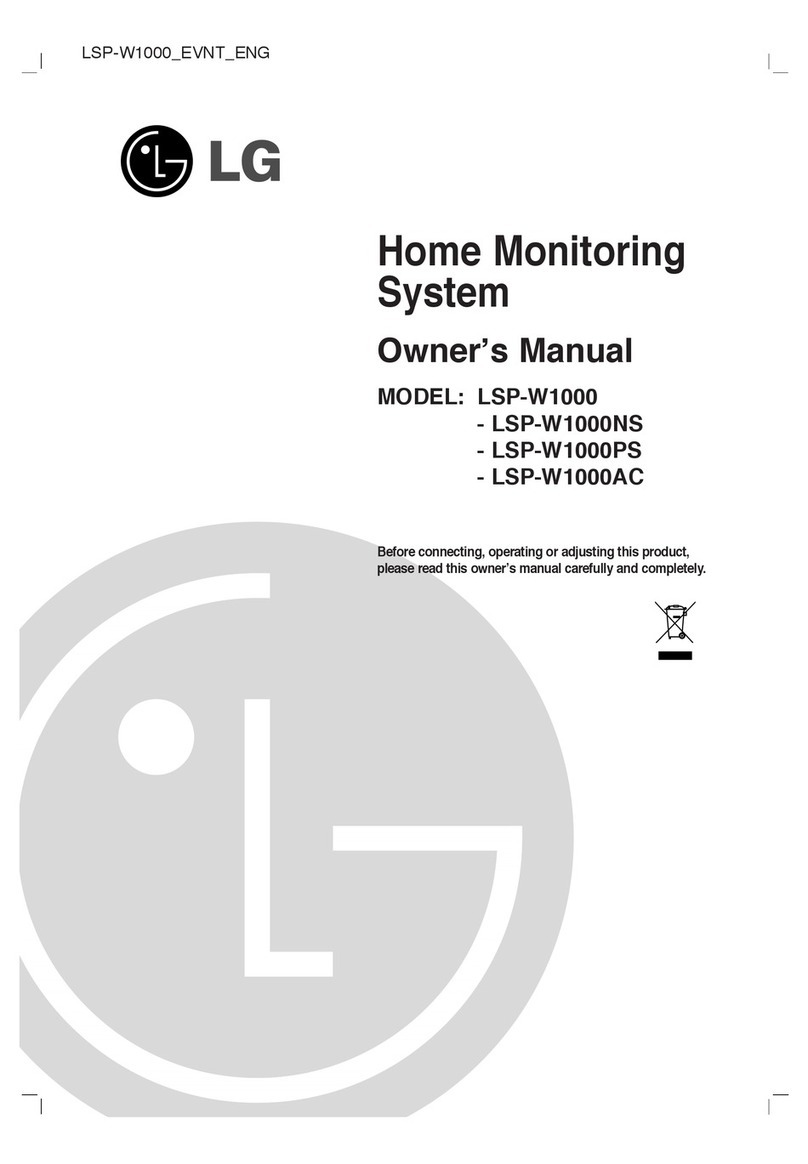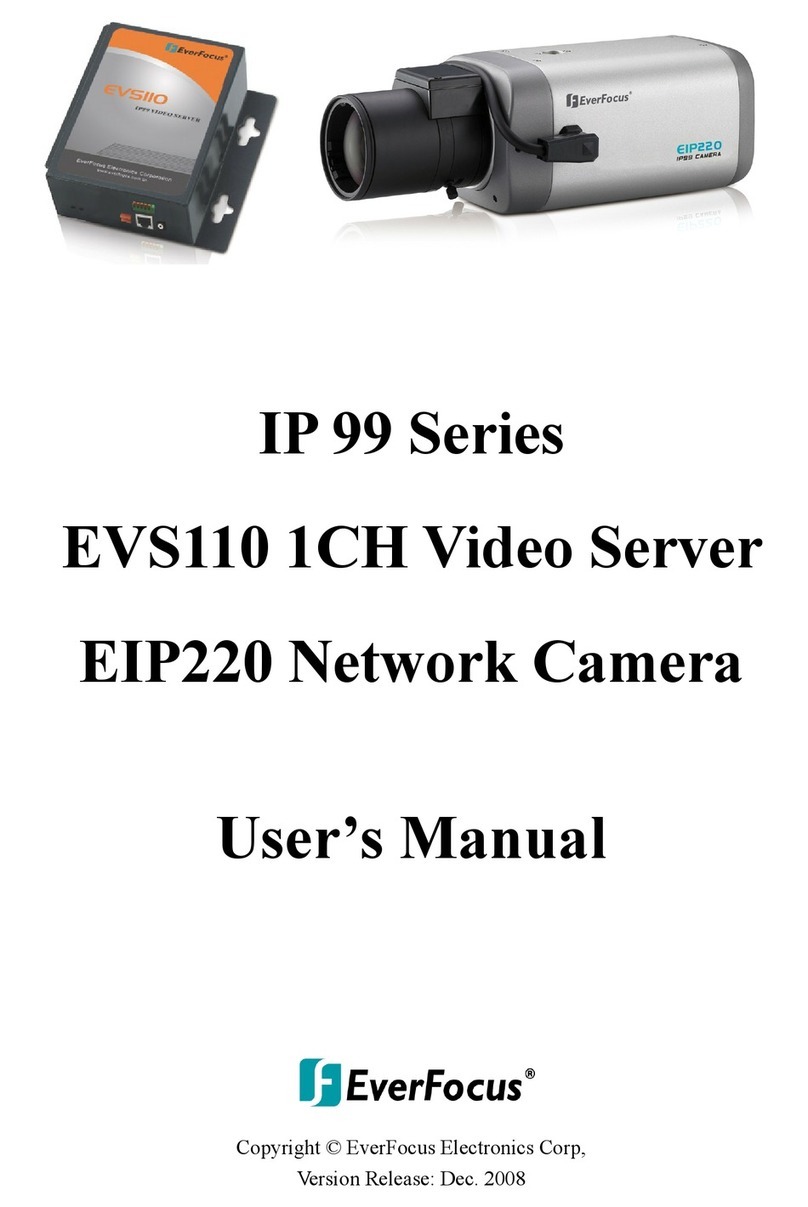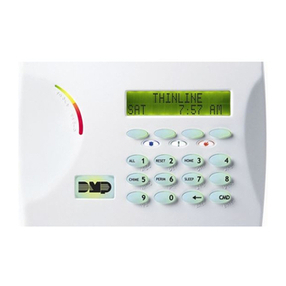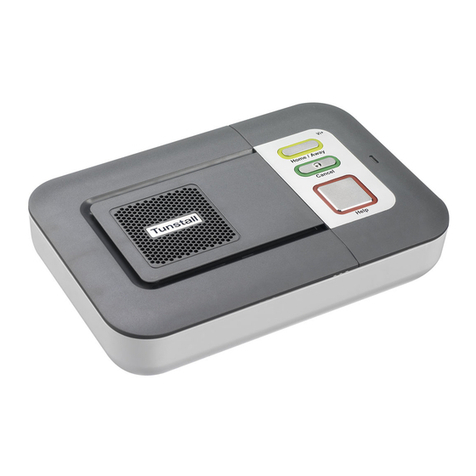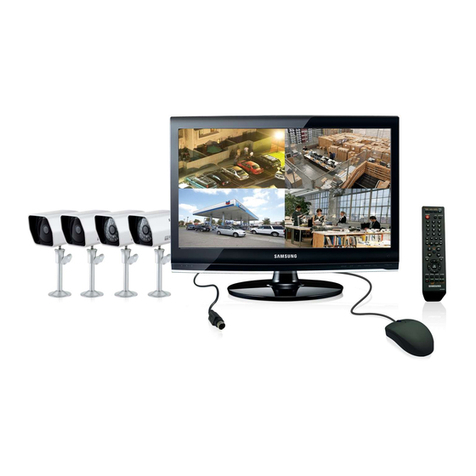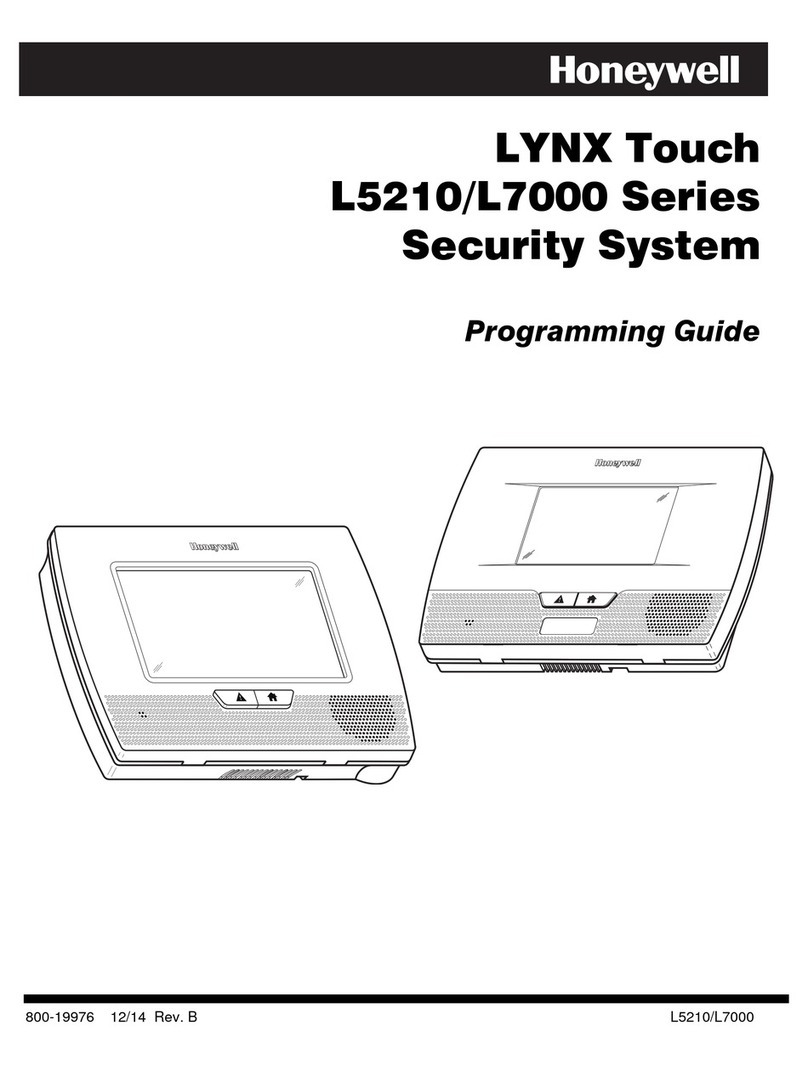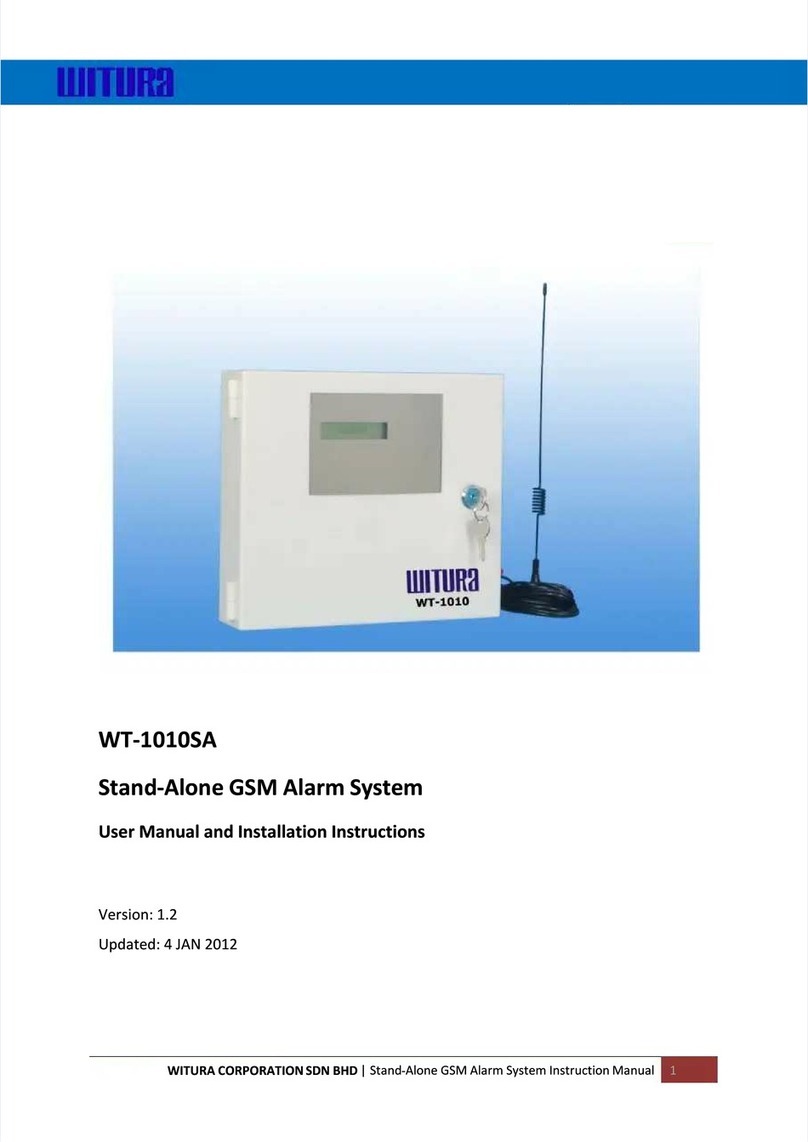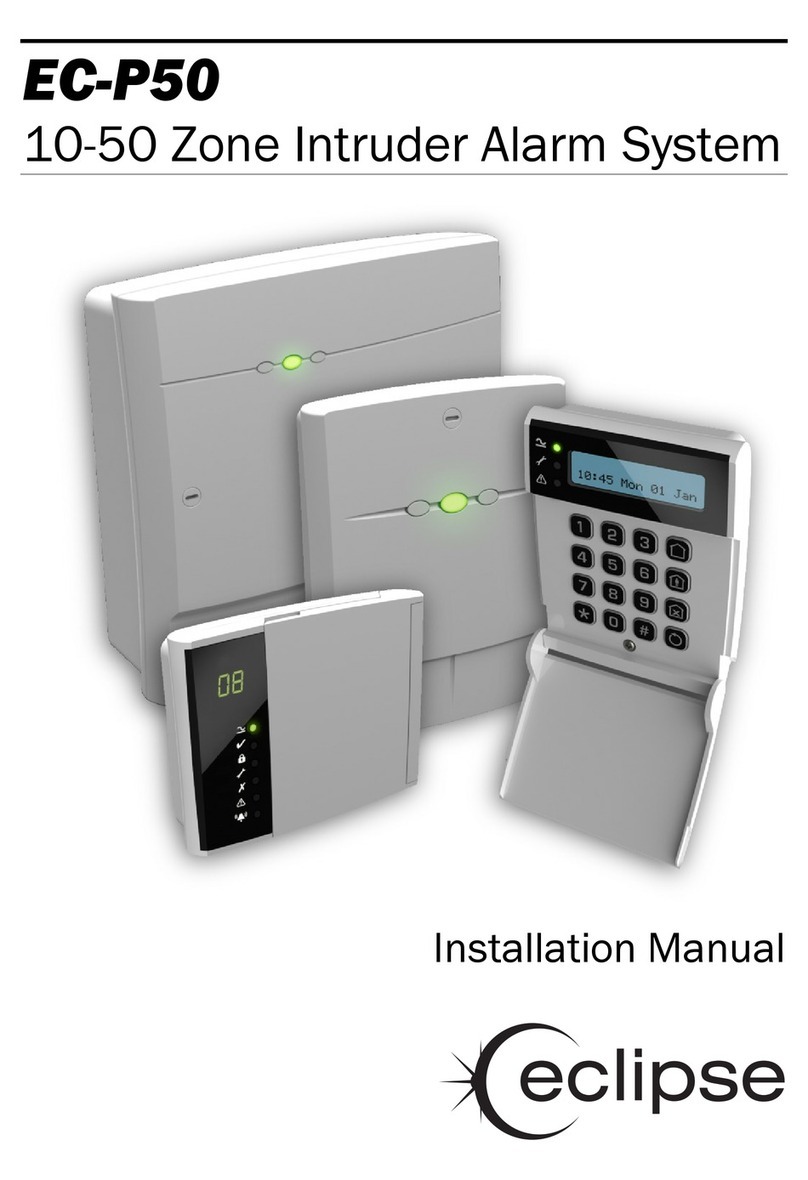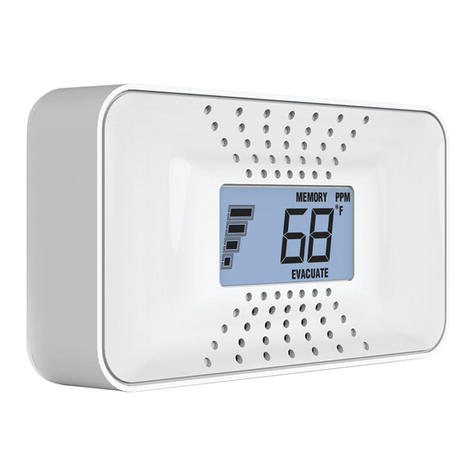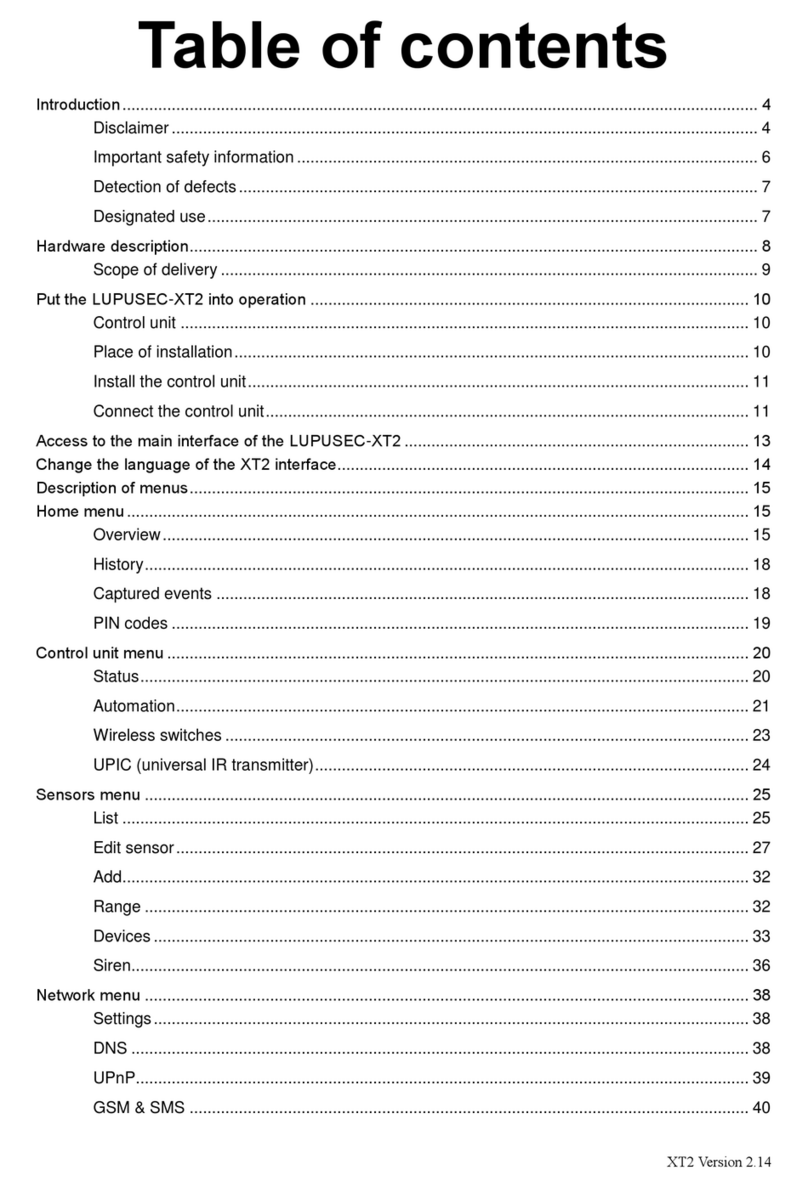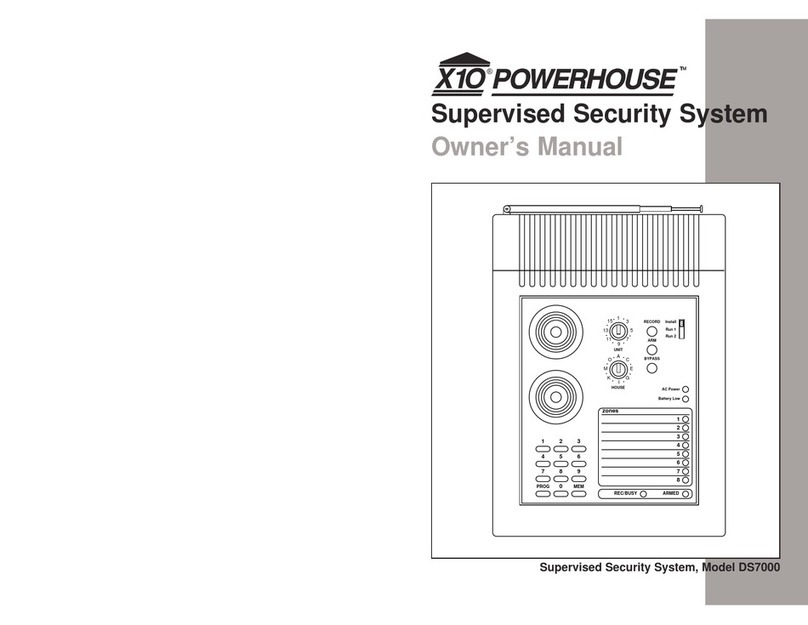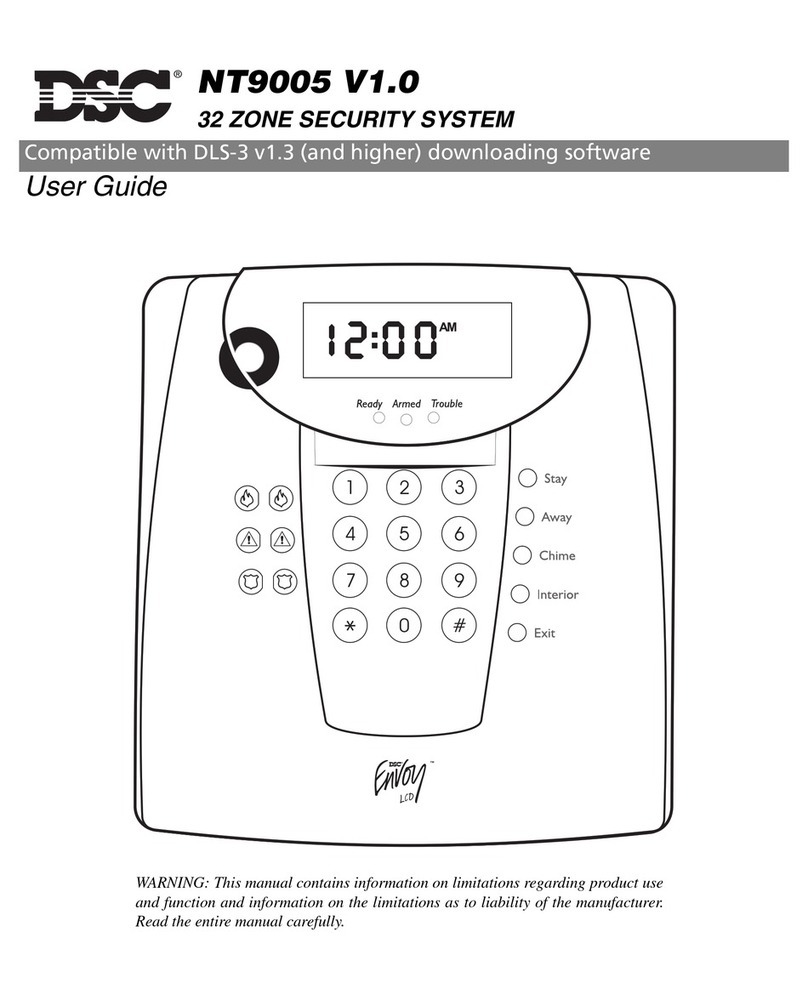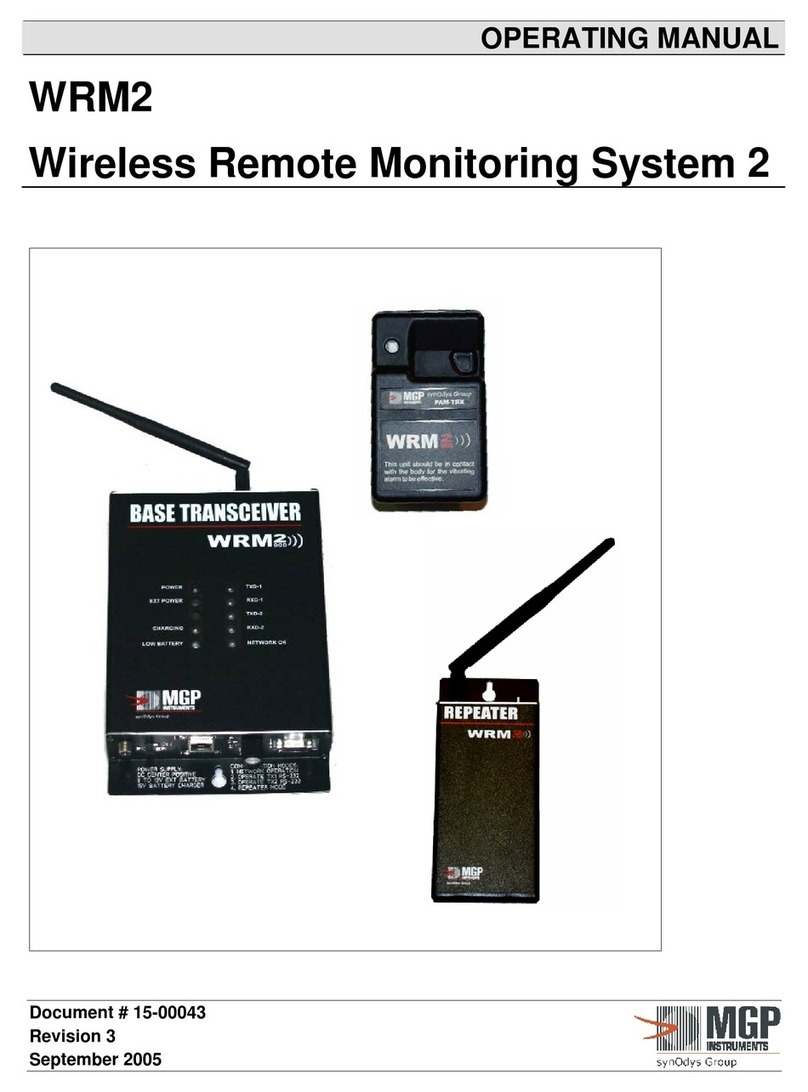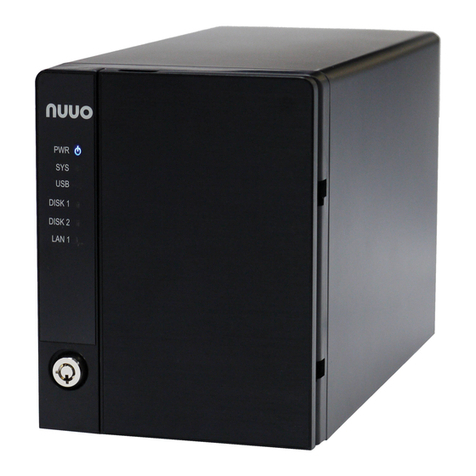SerVision HVG400 User manual

HVG400
Installation Guide
September
2013

SerVision HVG400 Installation Guide
2
Trademarks & Copyright
Trademarks
All trademarks mentioned in this manual are the sole property of their respective manufacturers.
Copyright
SerVision Ltd., Jerusalem, Israel
www.servision.net • info@servision.net
© 2013 SerVision Ltd. All rights reserved.
Notice
Information in this document is subject to change without notice. SerVision Ltd. assumes no responsibility for any
errors that may appear in this manual. Companies, names and data used in examples herein are fictitious unless
otherwise noted. No part of this document may be copied or reproduced in any form, or by any means, electronic or
mechanical, for any purpose, without the express written permission of SerVision Ltd. SerVision Ltd. makes no
warranties with respect to this documentation and disclaims any implied warranties of merchantability or fitness for
a particular purpose.

SerVision HVG400 Installation Guide
3
Table of Contents
Introduction 4
The HVG400 Package 5
Additional Equipment 6
Installing the HVG400 System 7
Selecting a Location for the Unit 7
Diagram of the Rear Panel 7
Connecting Devices to the HVG400 9
Connecting Cameras 9
Connecting PTZ Controllers 9
Connecting Sensors 10
Connecting a Sensor Directly to the Unit 11
Connecting Sensors Using an ADAM Module 11
Connecting Activators 15
Connecting Sensors and Activators Using an IA Relay Board 15
Connecting Microphones 17
Connecting a Speaker or Headphones 17
Connecting a CCTV Monitor 18
Connecting the Mouse 18
Connecting a Switch 19
Connecting Multiple Monitors 19
Connecting the HVG400 to the Network 20
Connecting the HVG400 to a Power Source 21

SerVision HVG400 Installation Guide
Introduction 4
Introduction
This guide explains how to set up the hardware components of SerVision’s HVG400 security system. The HVG400
belongs to SerVision’s line of embedded Video Gateway units. These units provide state-of-the-art security
functionality, including live video streaming, video recording and playback, motion detection, sensor management,
real-time event notification, and device activation. All of these features can be accessed remotely via PC, PDA, or
cellular telephone. The standard HVG400 is optimized for deployment in homes and businesses in which high-
speed internet access is available through a cable-based local network (LAN).
Once the HVG400 has been installed as explained in this guide, it must be configured. Configuration is performed
by connecting to the HVG400 unit using a PC that is on the same network as the unit (or connected to the unit
directly using a LAN cross cable) and opening the unit’s configuration utility in a browser. For additional
information about configuring your HVG400, please refer to the Embedded Video Gateway System Guide.
Client software is used for accessing the HVG400 unit remotely in order to view video and events and control the
system in various ways. SerVision offers client software for PCs and for certain cellular telephone and PDA
models. Full instructions for the use of the client applications are available in separate manuals, which can be
downloaded at http://www.servision.net.

SerVision HVG400 Installation Guide
The HVG400 Package 5
The HVG400 Package
The HVG400 package contains the following items:
Item
Description
Illustration
HVG400 unit
Video Gateway
Power supply cable
Connects the unit to an
electrical outlet
Ethernet (LAN)
cable
Connects the unit to a network
RS232/485 adapter
Connects PTZ controllers to the
unit
Mouse
Mouse for use with CCTV
monitors

SerVision HVG400 Installation Guide
Additional Equipment 6
Additional Equipment
Up to four video cameras can be connected to the HVG400. You must acquire the cameras you require; they are not
included in the HVG400 package. For information about camera compatibility and about connecting the cameras to
the unit, see Connecting Cameras, page 9, or consult your vendor.
In addition to the cameras, you may wish to incorporate some or all of the optional equipment listed below into your
security system. For additional information about these items and the cables required to connect them, please refer
to the installation instructions for each type of device.
NOTE: This equipment is not included in the HVG400 package.
Up to six dry-contact sensors (see Connecting Sensors, page 10)
Note: Up to six dry-contact sensors can be connected directly to the HVG400 unit. If you use either an
ADAM module or an IA relay board, as described below, you can connect an additional 16 dry-contact
sensors via the unit’s RS232/485 connector.
ADAM Data Acquisition Module and ADAM isolated RS232->RS422/RS485 converter, for connecting up to
16 dry-contact sensors (see Connecting Sensors, page 10)
Intelligent Appliance IA-3126-2 relay board, for connecting up to 16 dry-contact sensors (see Connecting
Sensors and Activators Using an IA Relay Board, page 15) and 16 activators to the HVG400 unit
Up to two dry-contact activators (alarms or other devices that are turned on or off in response to the activation
of a sensor; see Connecting Activators, page 15)
Note: Up to two activators can be connected directly to the HVG400 unit. If you use an IA relay board, as
described above, you can connect an additional 16 activators via the unit’s RS232/485 connector.
Up to two microphones (see Connecting Microphones, page 17)
Speaker or headphones (the unit already contains a built-in speaker; see Connecting a Speaker or Headphones,
page 17)
CCTV monitor for closed-circuit video display (see Connecting a CCTV Monitor, page 18)
Push-button switch to change the display in a connected CCTV monitor (see Connecting a Switch, page 19)
Toggle (on-off) switch to change the active outline (see Connecting Sensors, page 10)

SerVision HVG400 Installation Guide
Installing the HVG400 System 7
Installing the HVG400 System
These are the steps that you will typically follow in order to install the HVG400 system:
1. Place the HVG400 unit in its desired location; see Selecting a Location for the Unit, page 7.
2. Install the video cameras in their desired locations.
3. Install the sensors in their desired locations (optional).
Note: Six sensors can be connected directly to the unit; another 16 can be connected through an ADAM
module or an IA relay board; see Connecting Sensors, page 10.
4. Install a toggle switch in its desired location (optional); the toggle-button switch can be used to change the
active outline; see Connecting Sensors, page 10.
5. Install the activators in their desired locations (optional).
Note: Two activators can be connected directly to the unit; another 16 can be connected through an IA relay
board; see Connecting Activators, page 15.
6. Install a CCTV monitor in its desired location (optional).
Note: If you want to use a mouse to control the TV-Out, place the monitor close to the HVG400 unit, because
the mouse is plugged into the unit, not into the monitor.
7. Install a push-button switch in its desired location (optional); the push-button switch can be used to change the
display on the CCTV monitor, if a monitor is connected to the unit; see Connecting Sensors, page 10.
8. Connect the cameras and other devices to the HVG400 and to a power supply, as required; see Connecting
Devices to the HVG400, page 9.
9. Connect the unit to a LAN using an Ethernet cable (optional); see Connecting the HVG400 to the Network,
page 20.
10.Connect the HVG400 unit to a power source; see Connecting the HVG400 to a Power Source, page 21.
Selecting a Location for the Unit
The HVG400 unit should be placed on a flat surface such as a table or shelf. (It is not designed for mounting
directly on a wall.) Ensure the unit has at least a few centimeters (1–2 inches) of space above it and on all sides for
ventilation.
When choosing a location for the HVG400, bear in mind that the unit must be connected to a power outlet and a
LAN or a PC, and that other devices (cameras, sensors, etc.) must be connected to it. Choose a location in which
these connections are feasible.
Diagram of the Rear Panel
The rear of the HVG400 unit contains the connectors and controls described below.

SerVision HVG400 Installation Guide
Installing the HVG400 System 8
Figure 1: HVG400 connectors and controls
Connector/Control
Description
Reset
Reset button. Use a pin to press the button when it is necessary to
reset the unit manually.
Note: Your configuration settings will not be lost during a reset.
Power
Connector for the power supply (see page 21)
Audio Out (Aout)
Connector for an external speaker or headphones (see page 17)
Audio In2 (Ain2)
Connector for an active microphone (see page 17)
Audio In1 (Ain1)
Connector for a passive microphone (see page 17)
TV Out
Connector for a CCTV monitor (see page 18)
Video In (Vin1–Vin4)
Connectors for video cameras (see page 9)
Ethernet Out
10/100 Base-T LAN connector for connecting the unit to an external
network (LAN or WAN; see page 20)
RS232/485
Serial (COM) port for PTZ controllers (see page 9), ADAM modules (see
page 11), or technicians' use
Mouse Connector
Mouse connector (for the supplied PS2 mouse only; see page 18)
Audio Mute
Switch to turn the internal speaker on or off (see page 17)
Sensors (In1 –In 6)
Sensor connectors (see page 10)
Activators (Out1, Out2)
Activator connectors (see page 15)
Reset
Power
Audio Out (Aout)
Audio In2 (Ain2)
Audio In1 (Ain1)
TV Out
Ethernet Out
Video In
Vin1–Vin4
RS232/485
Mouse Connector
Audio Mute
Sensors
In1–In6
Activators
Out1, Out2

SerVision HVG400 Installation Guide
Connecting Devices to the HVG400 9
Connecting Devices to the HVG400
This section explains how to connect cameras, sensors, activators, microphones, a speaker or headphones, and a
CCTV monitor to the HVG400 unit.
Connecting Cameras
Up to four cameras can be connected to the HVG400. If the cameras have PTZ controls for remote aiming and
zooming, and the PTZ protocols they use are supported, the control cables can also be connected to the unit.
Any PAL or NTSC video camera with a composite video output can be connected to the unit. A cable with a
composite video connector on one end, and a male BNC connector on the other, should be used to connect each
camera to the HVG400.
To connect a camera:
1. Install the camera in its desired location.
2. Connect the output of the camera to one of the Video In connectors on the rear panel of the unit.
3. Connect the camera's power supply cable to an electrical outlet.
Connecting PTZ Controllers
If a camera has remote PTZ control features (pan, tilt, zoom, and/or focus), and uses a supported PTZ protocol, you
can connect the control cable to the unit. Both RS232 and RS485 PTZ connection types are supported. Consult the
camera documentation for information about which connection type to use.
NOTE: If you are connecting sensors to the unit using an ADAM module, you cannot connect any RS232 PTZ
controllers to the unit. For additional information, see Connecting Sensors Using an ADAM Module,
page 11.
If you want to connect the PTZ controllers of multiple cameras to the unit, only one of the controllers can use an
RS232 connector –the others must all use RS485 connectors. PTZ controllers for more than one RS232 camera
cannot be connected to the unit simultaneously.
If you connect multiple RS485 PTZ camera controllers, they should be daisy-chained to the RS232/485 connector,
as described below. In this case, each camera in the chain must be given a different ID number. Please refer to your
camera's documentation for information about configuring its ID number. In addition, note that you can only create
an RS485 daisy chain if every link on the chain (i.e., every camera) uses the same PTZ protocol. Attempting to
connect cameras that use different protocols will prevent all of the cameras from working properly.
NOTE: A cable with a male RCA connector can be connected to a female BNC connector by using an RCA-
to-BNC adaptor.
Figure 2: RCA-to-BNC adaptor

SerVision HVG400 Installation Guide
Connecting Devices to the HVG400 10
To connect an RS232 PTZ controller:
The RS232 controller cable should end with a female 9-pin RS232 connector.
If you are only connecting the RS232 PTZ controller to the unit, and are not connecting any RS485 PTZ
controllers, plug the 9-pin RS232 connector directly into the RS232/485 connector on the rear panel of the
unit.
If you are also connecting one or more RS485 PTZ controllers to the unit, plug the 9-pin RS232 connector into
the RS232/485 adapter supplied with the unit.
To connect an RS485 PTZ controller:
Each RS485 controller cable should end with two wires.
1. Use a wire connector to connect the wires to the RS485 connection wires of the adapter. Be sure to match the
positive (+) wire of the controller cable to the positive (+ red) wire of the adapter, and the negative (-) wire of
the controller cable to the negative (- grey) wire of the adapter (see figure 3).
Figure 3: RS232/485 adapter
To connect multiple RS485 controllers to the adapter, insert the positive (+) wires of all of the controllers into
one slot in the wire connector, and the negative (-) wires of all of the controllers into the other slot of the wire
connector.
Figure 4: Wire connector
2. If multiple PTZ cameras are connected to the unit, configure each camera to use a different ID. For
information about how to do this, refer to the camera documentation.
3. Connect the RS232/485 adapter to the RS232/485 connector on the rear panel of the unit.
Connecting Sensors
Sensors are devices that detect events such as a door being opened or a light being turned on. Up to six dry-contact
input sensors can be connected directly to the unit. In addition, if you wish, you can connect either an ADAM Data
RS485 connection wires
Plug into RS232/485
connector on MVG 400HVG
RS232 connector
Positive (+) wire for RS485
connector (red)
Negative (-) wire for
RS485 connector (grey)

SerVision HVG400 Installation Guide
Connecting Devices to the HVG400 11
Acquisition Module or an IA-3126-2 relay board to the unit. Either of these devices makes it possible to connect up
to 16 additional sensors to the unit.
Sensor 1 and Sensor 6 can be used as switches instead of sensors. The switches can be used to activate outlines and
to change the display on a CCTV monitor.
Connecting a Sensor Directly to the Unit
The unit has six sensor connectors (In1 –In6). You can use these connectors to connect up to six dry-contact input
sensors directly to the unit. Alternatively, In1 and In6 can be used to connect switches as follows:
In1: If you are defining more than one outline (alternate sets of recording and event-handling settings), you
can connect a toggle (on-off) switch to In1 instead of a sensor. The switch can then be used to change the
active outline. For additional information, please refer to the Embedded Video Gateway System Guide.
Note: Some alarm panels can also be connected to In1. When they are, they can function as automatic outline
toggle switches. For additional information, please consult the alarm panel vendor.
In6: If a CCTV monitor will be connected to the unit, you can connect a push-button switch to In6 instead of
a sensor. The button can then be used to change the display on the monitor. For additional information, see
Connecting a CCTV Monitor, page 18 and refer to the Embedded Video Gateway System Guide.
To connect a sensor or switch directly to the unit:
1. Install the sensor or switch in its desired location in accordance with the manufacturer's instructions.
2. Connect the two wire contacts of the sensor or switch to the Sensors terminal block on the rear panel of the
HVG400, as illustrated in figure 5. Insert the wires into the connectors and tighten the screws below each
connector to hold the wires in place.
Note: The wires must be connected to two adjacent contacts in the same group (e.g. the two contacts of
“In1”), but the polarity does not matter.
Figure 5: Connecting a sensor
Connecting Sensors Using an ADAM Module
If you want to connect additional dry sensors to the HVG400, you can do so by connecting an ADAM Data
Acquisition Module to the unit. Up to 16 additional dry sensors can then be connected to the unit through the
ADAM module.
NOTE: Alternatively, you can connect additional sensors using an IA-3126-2 relay board, as explained
Connecting Sensors and Activators Using an IA Relay Board, page 15.
To connect sensors using an ADAM module, you will need the following items:
ADAM-4051 Data Acquisition Module (available from SerVision)
ADAM-4520 isolated RS232->RS422/RS485 converter (available from SerVision)
In1 In2 In3 In4
Sensor
Sensors terminal block
HVG rear panel

SerVision HVG400 Installation Guide
Connecting Devices to the HVG400 12
Flat ribbon cable with D-type 9-pin female connector on one end and a D-type 9-pin male connector on the
other end
Wire to connect the ADAM module to the ADAM converter –red, black, yellow, and green
Wire and an electrical plug (optional) to connect the ADAM module to a power source
Figure 6: ADAM-4051 module
Figure 7: ADAM-4520 isolated converter
NOTE: The instructions below explain how to connect sensors to the HVG400 using the ADAM module and
converter described above. For additional information about connecting and configuring the ADAM
module and converter, please refer to the manufacturer's documentation, or contact your vendor.
To connect sensors using an ADAM module:
1. Install the sensors in their desired locations in accordance with the manufacturer's instructions.
2. Connect the wire contacts of each of the sensors to the terminal blocks of the ADAM-4051 module as follows:
Connect all of the negative (-) wires of all of the sensors to one of the ground (D GND) connectors on the
ADAM module. If the wires cannot all be inserted into the connector, use a wire connector to connect
them together, and then connect the wire connector to the ground (D GND) connector on the ADAM
module.
Connect each of the positive (+) sensor wires to one of the numbered connectors (D1 0 through D1 15) in
the terminal blocks of the module.

SerVision HVG400 Installation Guide
Connecting Devices to the HVG400 13
Figure 8: Connecting sensors to the ADAM-4051 module
3. Connect the ADAM-4051 module to the ADAM-4520 isolated converter as follows (see figure 10, page 14):
Connect this connector on
the ADAM-4051
To this connector on the
ADAM-4520
(Y) Data+
Data+
(G) Data-
Data-
(R) +Vs
(R)+Vs
(B) GND
(B)GND
4. Connect the ADAM-4520 isolated converter to the RS232/485 connector on the rear panel of the HVG400
unit in one of the following ways:
If you are not connecting any RS485 PTZ controllers to the unit, using the 9-pin flat ribbon cable, connect
the RS232 connector of the ADAM-4520 converter directly into the RS232/485 connector.
If you are also connecting one or more RS485 PTZ controllers to the unit, using the 9-pin flat ribbon
cable, connect the RS232 connector of the ADAM-4520 converter into the RS232 connector of the
RS232/485 adapter supplied with the unit. Connect the PTZ controllers to the adaptor as explained under
Connecting PTZ Controllers, page 9. Then plug the adaptor into the RS232/485 connector on the unit.
D GND
Connect sensor ground
wires to this connector
D1 0
through
D1 10
Connect positive (+) sensor wires
to these connectors
D1 11
through
D1 15
Connect positive (+) sensor
wires to these connectors
D GND
Connect sensor ground
wires to this connector

SerVision HVG400 Installation Guide
Connecting Devices to the HVG400 14
Figure 9: RS232/485 adapter
Note: If you connect an ADAM module to the unit, you cannot connect any RS232 PTZ controllers or an IA
relay board to the unit. For additional information about connecting PTZ controllers to the unit, see
Connecting PTZ Controllers, page 9. For information about connecting an IA relay board to the unit, see
Connecting Sensors and Activators Using an IA Relay Board, page 15.
5. Connect the ADAM-4051 module to the power source as follows (see figure 10, page 14):
Connect the positive (+) wire of the power supply cable to the (R) +Vs connector on the module
Connect the negative (-) wire of the power supply cable to the (B) GND connector on the module
Note: Each of the power connectors on the module will then have two wires connected to it –one connecting
it to the power supply, and one connecting it to the power connectors of the ADAM-4520 converter.
Figure 10: Connecting the module to the converter, the HVG400, and the power supply
Connect to RS232/485
connector on the HVG
(Y) Data +
(G) Data -
(R) +Vs
(B) GND
Connect to power
supply (-)
Connect to power
supply (+)
Plug into RS232/485
connector on HVG
RS232 connector

SerVision HVG400 Installation Guide
Connecting Devices to the HVG400 15
Connecting Activators
Activators are external devices such as alarms and lights that can be turned on by the system in response to an
event. Essentially, the unit functions as an on/off switch for these devices. The unit activates an activator by closing
the circuit of its power supply. Two activators can be connected directly to the unit. In addition, if you wish, you
can connect an IA-3126-2 relay board to the unit. This makes it possible to connect up to 16 additional activators to
the unit (see Connecting Sensors and Activators Using an IA Relay Board, page 15).
In addition to the activators themselves, you will need 16 AWG red and black cables to connect each activator to
the unit.
To connect an activator:
1. Install the activator in its desired location in accordance with the manufacturer's instructions.
2. Connect the two contacts of the activator to the Activators terminal block on the rear panel of the HVG400, as
illustrated in figure 11.
Note: The wires must be connected to two adjacent contacts in the same group (e.g. the two contacts of
“Out1”), but the polarity does not matter.
Figure 11: Connecting an activator that has its own power supply
Connecting Sensors and Activators Using an IA Relay Board
If you want to connect additional dry sensors and/or two activators to the HVG400, you can do so by connecting an
Intelligent Appliance IA 3126-2 relay board to the unit. Up to 16 additional dry sensors and 16 additional activators
can then be connected to the unit through the relay board. Sensor and activator events from devices connected to an
IA relay board can be seen in SerVision client applications and activators can be turned on and off via these
applications. However, the sensors and activators cannot be configured using the HVG400’s configuration utility.
NOTE: Alternatively, you can connect additional sensors using an ADAM module, as explained under
Connecting Sensors Using an ADAM Module, page 11. Sensors that are connected through an ADAM
module can be configured using the HVG400’s configuration utility.
Out1 Out2
+ -
+ -
Activators
terminal block
MVG 400HVG rear
panel
+
Power
-
Activator

SerVision HVG400 Installation Guide
Connecting Devices to the HVG400 16
Figure 12: IA 3126-2 relay board
For information about connecting sensors and activators to the IA 3126-2 relay board, and about connecting the
relay board to a power source, please consult the relay-board’s documentation.
NOTE: If you are connecting less than 16 activators or 16 sensors to the relay board, be sure to connect them to
the relay beginning with the lowest connector, and do not leave open connectors between those that
you use. For example, if you are connecting 4 activators and 3 sensors, connect the activators to output
connectors 1-4 on the board and the sensors to input connectors 1-3 on the board.
To connect the IA 3126-2 relay board to the HVG400:
1. Set the ID of the relay board to 0. (For information about how to do this, consult the relay-board
documentation.)
2. Connect the relay board to the RS232/485 connector on the rear panel of the HVG400 unit in one of the
following ways:
If you are not connecting any RS485 PTZ controllers to the unit, using a 9-pin flat ribbon cable, connect
the RS232 connector of the relay board directly into the RS232/485 connector.
If you are also connecting one or more RS485 PTZ controllers to the unit, using a 9-pin flat ribbon cable,
connect the RS232 connector of the relay board into the RS232 connector of the RS232/485 adapter
supplied with the unit. Connect the PTZ controllers to the adaptor as explained under Connecting PTZ
Controllers, page 9. Then plug the adaptor into the RS232/485 connector on the unit.

SerVision HVG400 Installation Guide
Connecting Devices to the HVG400 17
Figure 13: RS232/485 adapter
Note: If you connect a relay board to the unit, you cannot connect any RS232 PTZ controllers or an ADAM
module to the unit. For additional information about connecting PTZ controllers to the unit, see Connecting
PTZ Controllers, page 9. For information about connecting an ADAM module to the unit, see Connecting
Sensors Using an ADAM Module, page 11.
Connecting Microphones
Up to two microphones can be connected to the unit, one active and one passive. When one or two microphones are
connected, you can hear and record sound along with video images. The sound from a microphone can be
associated with any or all of the cameras. (For additional information, please refer to the Embedded Video Gateway
System Guide.)
Microphones can be connected to one or both of the Audio In connectors (Ain1 and/or Ain2). Passive
microphones, which require external amplification, must be connected to Ain1. Active (self-amplifying)
microphones must be connected to Ain2. Microphones with an output voltage of 1 Vrms or 1.41 Peak are
supported.
To connect a microphone:
1. Install the microphone in the desired location.
2. Plug the microphone connector into the desired Audio In connector (Ain1 or Ain2).
Connecting a Speaker or Headphones
The HVG400 unit contains a built-in, 1-watt, internal speaker, which is located on the right side of the unit. You
can also connect an external speaker or headphones to the unit. The speakers (and headphones) allow you to hear
audio that is transmitted from one of the client applications. In addition, if you are viewing recorded video on a
CCTV monitor, these speakers can broadcast the audio associated with the video. The external speaker or
headphones can be used in addition to the internal speaker or instead of it. (For additional information, please refer
to the Embedded Video Gateway System Guide.)
Plug into RS232/485 serial port
connector on HVG
RS232 connector

SerVision HVG400 Installation Guide
Connecting Devices to the HVG400 18
Figure 14: Internal speaker
To connect a speaker or headphones:
1. Install the speaker in its desired location, if necessary.
2. Plug the speaker or headphone connector into the Audio Out (Aout) connector.
Connecting a CCTV Monitor
You can connect a CCTV monitor to the unit. The monitor offers an alternative way to view live or recorded video
from the HVG400. It is primarily useful if you want to view video when you are near the unit. For example, if the
HVG400 is set up in a grocery store, and you sit at the check-out counter, you can use a CCTV monitor to keep tabs
on parts of the store that you cannot see from your seat.
The following types of monitors can be used:
Surveillance monitors: Monitors that are designed to be plugged directly into surveillance cameras.
Entertainment monitors: Monitors that are intended to be plugged into portable DVD players in vehicles.
Standard television sets with AV connectors
When choosing a monitor to connect to the unit, ensure the monitor supports the video format used by the cameras
(NTSC or PAL). Some SECAM monitors will also work when the PAL video format is used.
To connect the monitor to the HVG400, you will need a cable with the following connectors:
An appropriate connector (BNC or RCA) for the Video In connector of the monitor. (Consult the monitor
documentation or your vendor to find out which kind of connector is required for the particular monitor you
are using.)
A BNC male connector to connect to the TV Out connector of the HVG400. (A cable with an RCA connector
can be used by attaching a BNC-to-RCA adaptor to the connector. See figure 2, page 9.)
To connect a CCTV monitor:
1. Install the monitor in its desired location.
2. Connect the Video In connector of the monitor to the TV Out connector of the HVG400, using a cable with an
appropriate connector (BNC or RCA) for the Video In connector of the monitor on one end, and a BNC male
connector on the other end.
Note: If you are using a standard television set as a monitor, use the television’s AV connector as the Video
Input connector.
Connecting the Mouse
If you wish, you can also connect the supplied mouse to the HVG400 when the video monitor is connected. When
the mouse is connected, you can use it to control the screen display, select cameras, play recorded video, and
Internal speaker

SerVision HVG400 Installation Guide
Connecting Devices to the HVG400 19
activate PTZ controls (if available). For additional information, please refer to the Embedded Video Gateway
System Guide.
NOTE: Only the mouse supplied with the HVG400 is supported. If you connect a different mouse, the mouse
may be damaged.
To connect the mouse:
Plug the mouse into the Mouse Connector on the rear panel of the unit.
Connecting a Switch
If you wish, you can connect a switch to the unit to change the display on the monitor. The switch must be
connected to the Sensor 6 (In6) connector. For additional information, see Connecting Sensors, page 10 and refer to
the Embedded Video Gateway System Guide.
Connecting Multiple Monitors
If you wish, you can connect multiple CCTV monitors to the HVG400. For example, you may wish to have one
monitor beside a check-out counter, and another in the manager's office.
To connect multiple monitors, you must use video splitters to split the connection. Bear in mind, however, that the
image quality in each of the monitors will be slightly degraded. To correct this problem, you can use a video
amplifier (booster) for each monitor. To ensure you have the correct equipment, consult a video equipment supplier.
Note, also, that only one mouse can be connected to the unit. This means that there is only one point of control over
the display, and the display will be identical on all connected monitors.

SerVision HVG400 Installation Guide
Connecting the HVG400 to the Network 20
Connecting the HVG400 to the Network
The HVG400 should be connected to a local area network (LAN). Once connected, it can be accessed either from a
PC on the same LAN network or via the internet through the LAN’s gateway (router).
To connect the HVG400 unit to a LAN:
Connect the Ethernet Out connector on the rear panel of the HVG400 unit to a LAN connection point (a hub,
wall socket, or any other connection point) using the supplied Ethernet cable (see The HVG400 Package,
page 5).
Other manuals for HVG400
1
Table of contents
Other SerVision Security System manuals
